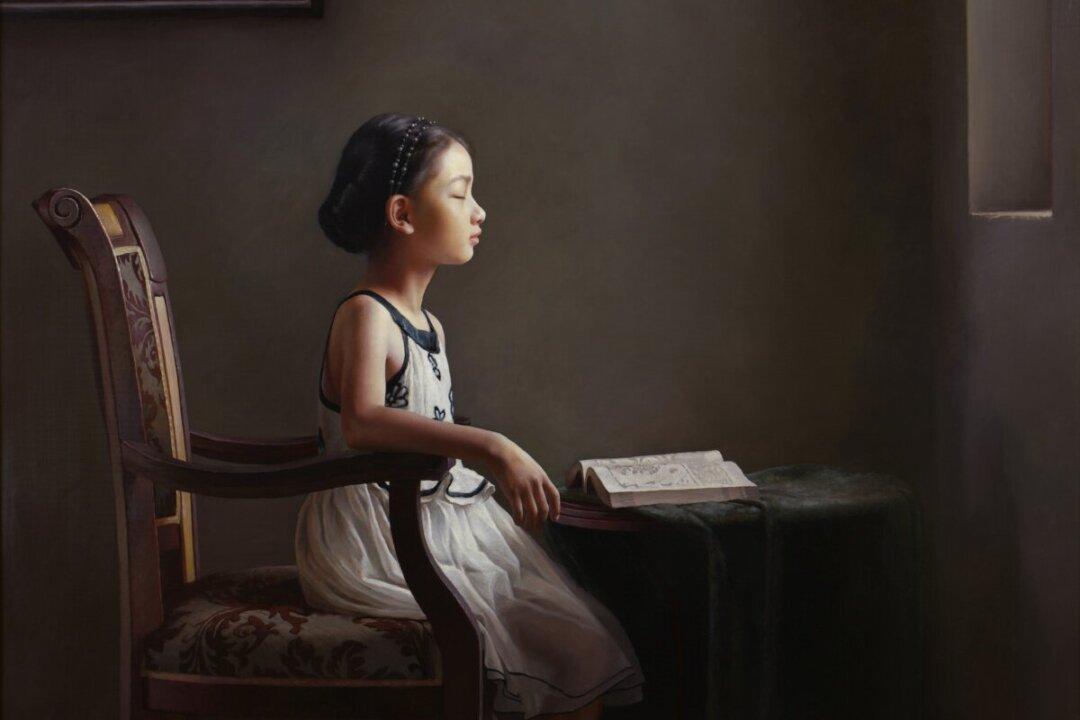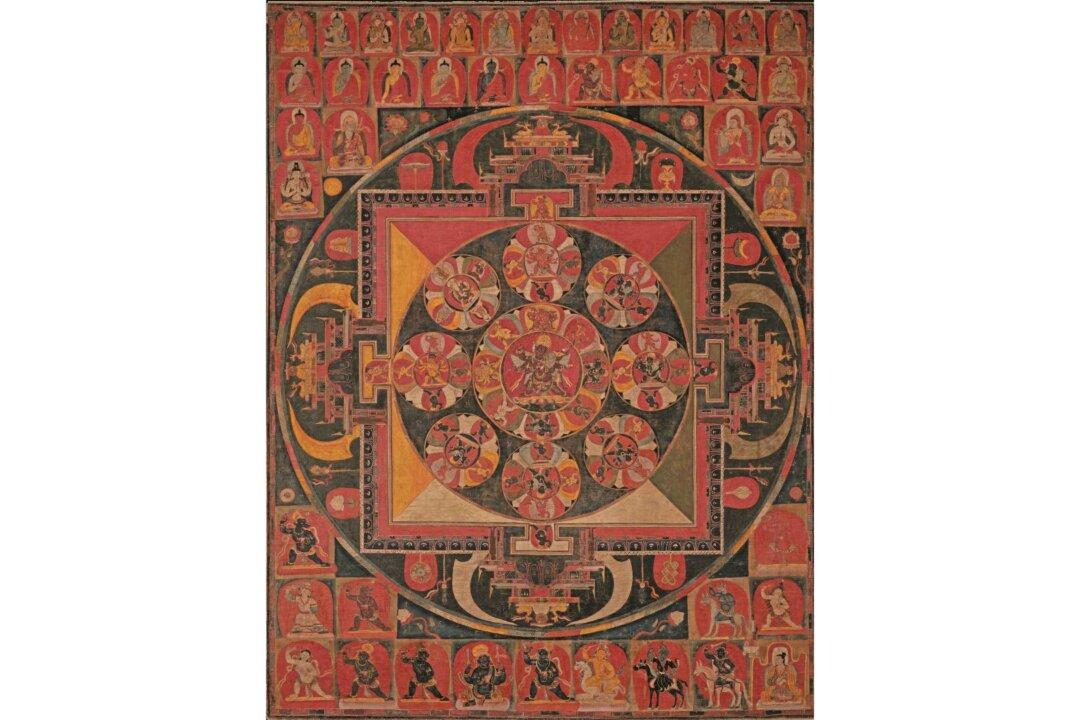FLORENCE, ITALY—Walking through the heart of Florence’s historic quarter, up the narrow street of Borgo San Frediano renowned for its artisans, you will find AtelierGK Firenze (Atelier Giannini and Kuwata of Florence), the workshop of bookbinder Lapo Giannini and paper and book conservator Michiko Kuwata.
Bookbinding runs through Giannini’s bloodline: As a sixth-generation Florentine bookbinder, he’s been working at his trade for some 25 years. Tokyo-born Kuwata has been conserving books for over 16 years in Florence, her adopted home. Together they set up shop eight years ago, but their customers mainly come from outside of Italy, from places such as New York and San Francisco in the United States, the UK, and France.
Keeping to the spirit of historic bookbinding, 19th-century wooden presses are put to work, along with manual machines such as steel guillotines and large metal presses from the more recent 1960s. Enter the shop and you are more likely to hear the soft sound of paper being torn or cut to size with small hand tools than the harsh whir of an engine.

Manual machinery used behind the scenes at AtelierGK Firenze. In the foreground the two front presses are from the 19th century and are used for detailed work on book spines. In the background is a 1960s metal press. (Lorraine Ferrier/The Epoch Times)
AtelierGK specializes primarily in bookbinding and book conservation, but Giannini and Kuwata also extend their traditional bookbinding skills to create custom-made luxury desktop objects: leather pen pots, letter racks, and desktop leather boxes, some topped with brass animals and lined with marble paper or suede; and for the tourists, ready-to-buy books that are machine-bound offsite but covered in-store with Florentine handmade paper. It’s a fine balance for many traditional craftspeople—how to effectively diversify in their business to stay afloat, without diluting their craft.
Giannini and Kuwata share how they have chosen to concentrate on preserving traditional bookbinding.
The Epoch Times: Why do you think it is important to keep the tradition of bookbinding alive?
Lapo Giannini: It’s part of our history and our culture, not only in my family but also all over the world. I think that bookbinding, papermaking, and printing are our human heritage.
Michiko Kuwata: When I studied the history of bookbinding, it was almost like the main part of human history was inside the story of papermaking, the story of printing, the history of letter writing, and the history of decorated paper. I think because this is our human history, our human heritage, then it has to be preserved.
The Epoch Times: How did you get into this traditional craft?
Ms. Kuwata: First, I studied in the field of restoration. But to restore books, I obviously had to know how to make a new one. So I started to study the history of bookbinding and printing on my own, and then here in Florence I studied at a private school of fine art restoration, and then worked at the conservation department of the National Central Library of Florence.
When I finished work in the national library, I restored books in a private studio for two years until the owner decided to close due to the economic slowdown. I found another job, and Lapo was one of the owners of the workshop. I’d always wanted to start my own business, so when he decided to establish his own company, we decided to start one together.
Mr. Giannini: My family established themselves as bookbinders in 1856, so from childhood I’ve grown up around the bottega, where the master works in his workshop and students watch and learn by apprenticeship.

The bookbinders who came before Lapo Giannini: (Top to bottom and left to right): Pietro Giannini (1811-1882); Giulio Giannini Sr. (1853-1931); Guido Giannini Sr. (1877-1956); Giulio Giannini Jr. (1901-1992); Gabriele Giannini (Lapo Giannini's father) and Lapo Giannini himself. (Lorraine Ferrier/The Epoch Times)
First, I learned bookbinding from my family, and then I went to Ascona, in Switzerland, to the international bookbinding school. In Italy, there are no artistic bookbinding competitions, so if we want to compete, we have to go overseas, outside of Italy, to England or France. Actually, the bookbinding tradition in Italy is not exactly protected, but it is respected in Switzerland, France, England, and maybe in the U.S. The reason is that here this field is considered to be only for tourism.
Actually, not only in our field but also in other artistic fields, Italian people have lost a lot of their appreciation for craftsmanship. Artisans here also don’t seem to do research anymore, don’t innovate anymore; they make, buy, or sell things that tourists buy. So it’s always things like Pinocchio or Michelangelo’s “David” in yellow, green, or pink, all made in China. There’s no more originality or personality.
In Italy, when people talk about artisans, many people think of Sunday markets, something childish, or something easy to buy, simple, and cheap. But it’s not. We often use this example: When cooking, there are many levels of chefs; some work in McDonalds, and some work in three-star Michelin restaurants. It’s the same in our field, or in an artist’s field.
The Epoch Times: What’s involved in binding a book?
Ms. Kuwata: It’s a long process, so it’s not easy to explain. Centuries ago, before the Industrial Revolution, books were simply printed and folded and then available in the library or bookshop. After reading, the buyer could then take the book to be bound by the bookbinder. After the Industrial Revolution, books were available as we now know them.
Mr. Giannini: Not all bookbinders know all the techniques we use. In particular, it’s difficult to explain, or to be understood, when we talk about making something more complex in bookbinding because there is a lot of research involved, many hours of work, and many materials, and so the price is more expensive.
The Epoch Times: Can you talk us through an example of your bookbinding?
Mr. Giannini: This book that I made in Switzerland in 1997 is an example of artistic bookbinding. The book cover is normally identified by the binder’s stamp on the inside of the cover. This book isn’t stamped, as it was a competition entry so needed to be anonymous.

Lapo Giannini’s artistic bookbinding made in English goatskin and finished with gold leaf, and its marble paper-covered book sleeve below, taking a total of one month to make. The book can be bought for 3,000 euros (approximately $3,500). (Lorraine Ferrier/The Epoch Times)

Lapo Giannini’s artistic bookbinding made in English goatskin and finished with gold leaf, taking a total of one month to make. The book can be bought for 3,000 euros (approximately $3,500). (Lorraine Ferrier/The Epoch Times)
In this example, a German typographer printed the text using a Gutenberg movable-type technique, a Renaissance invention which involves composing the text letter by letter. That’s why the text is printed on high-quality paper, so it can be conserved for centuries.

A type of patience: Lapo Giannini uses Gutenberg movable type where each letter is individually set into place before printing. (Lorraine Ferrier/The Epoch Times)

Closeup of the Gutenberg movable type showing the scale of lettering held in Lapo Giannini’s hands. (Lorraine Ferrier/The Epoch Times)

Lapo Giannini applies force to push the lettering into the leather. (Lorraine Ferrier/The Epoch Times)
The paper is cut by hand. Collectors prefer to leave at least two sides of the book with irregular page edges; the top edge is always cut with a guillotine as it gets soiled easily. The way the book is bound is quite a difficult technique as the cord goes inside the cardboard cover, which makes it stable and durable.

The book Lapo Giannini made in Switzerland in 1997 is open to show the print and pages: book collectors enjoy seeing the right and bottom edges of the high-quality paper unfinished. (Lorraine Ferrier/The Epoch Times)
The book took four weeks to make: two weeks to hand bind and make the cover without any decoration, and then another two weeks to decorate. This is without considering the research, design, and the printing of the text.

On the right: Giannini’s artistic bookbinding made in English goatskin and finished with gold leaf, taking a total of one month to make. The book can be bought for 3,000 euros (approximately $3,494). On the left: Book sleeve covered in marble paper and leather. (Lorraine Ferrier/The Epoch Times)
The Epoch Times: What materials do you use and where do you source them from?
Ms. Kuwata: Printing is another profession, so all our printed paper is supplied by the oldest typographers in Florence, just on the outskirts of Florence. They were established in 1901.
The marble paper, we make. Many people think that marble paper was invented in Florence, but that’s not true. It was probably invented in China, and then Japan more than 1,000 years ago.

Preparatory sketches of a liberty-inspired art noveau book cover sit next to the finished book. (Lorraine Ferrier/The Epoch Times)
For our book covers and desk objects, we use two types of naturally tanned leather. We mainly use Tuscan calfskin leather or suede, and we use English goatskin if the client requests it. Also, because we are in Florence, Tuscan leather is our traditional material.

From start to finish: A Renaissance style design sketch and the manual tools used to transfer the design on to the leather. (Lorraine Ferrier/The Epoch Times)
In Italy, we can find good-quality leathers but not for bookbinding. Those leathers are more for bags, jackets, shoes, clothes, and sofas. Leather for fashion or for interior design is treated with chemicals and waxed to make the material stain resistant.
In artistic bookbinding for competitions or for the book collectors, we use goatskin, which is durable, elastic, and a better quality. As we can’t find this quality in Italy, the goatskin comes from England. The prices are totally different: English goatskin is more than three times the price of Tuscan calfskin.
The Epoch Times: What notable book have you restored?
Ms. Kuwata: A book collector gave me “Metamorfosi,” the “Metamorphoses” by Ovid, to restore. It’s a collection of transformation myths chronicling world history up until Ovid’s time. It was a very important restoration project because it is a little tiny, tiny book published in Venice in 1572, so it’s very rare.

The condition of a book collector's 1572 edition of “Metamorfosi,” by Ovid, before its restoration. (AtelierGK Firenze)

Restoring a 1572 edition of “Metamorfosi,” the “Metamorphoses,” by Ovid. (AtelierGK Firenze)

The finished restoration of 1572 edition of “Metamorfosi,” the “Metamorphoses,” by Ovid. (AtelierGK Firenze)
Restoring a book is a long process, along with some professional secrets, so I cannot tell you everything. But we first disassemble the book, then clean everything page by page, and then restore page by page. Depending on the type of book, it can take anywhere from two weeks to several months. This one took more than one month working on it all day, every day.

Kuwata restores a local tailor’s 1950s pattern-making book to protect it for future generations. The bespoke tailor's refers to the book every day. (Lorraine Ferrier/The Epoch Times)
Everyone asks me, “What kind of book is it? What story is it?” Before I do the restoration, I do some research on the book. But when I actually restore it, I don’t read it because it slows me down; so I concentrate on the damage, not the text.
The Epoch Times: What do you want people to know about craftsmanship?
Mr. Giannini: We are all different; there are so many levels. So it’s like bespoke shoes or bespoke clothes: If you want something made for you, it has its cost. Actually, before the Industrial Revolution in the 19th century, everything was made by hand. Everything was bespoke or custom-made, and it was not cheap either. I don’t think it was cheap.
Many times, people don’t have the time or interest to understand this, but if people come inside and somebody is interested and asks us questions, we explain it.
Ms. Kuwata: Many people like everything ready-made, or if they want something custom-made, people want it immediately. It’s difficult to make people understand that to have something unique, or something made only for you, that you need to wait a little bit—not a whole year, but some days or weeks.
Ms. Kuwata acted as Mr. Giannini’s translator from Italian to English. This interview has been edited for clarity and brevity.








